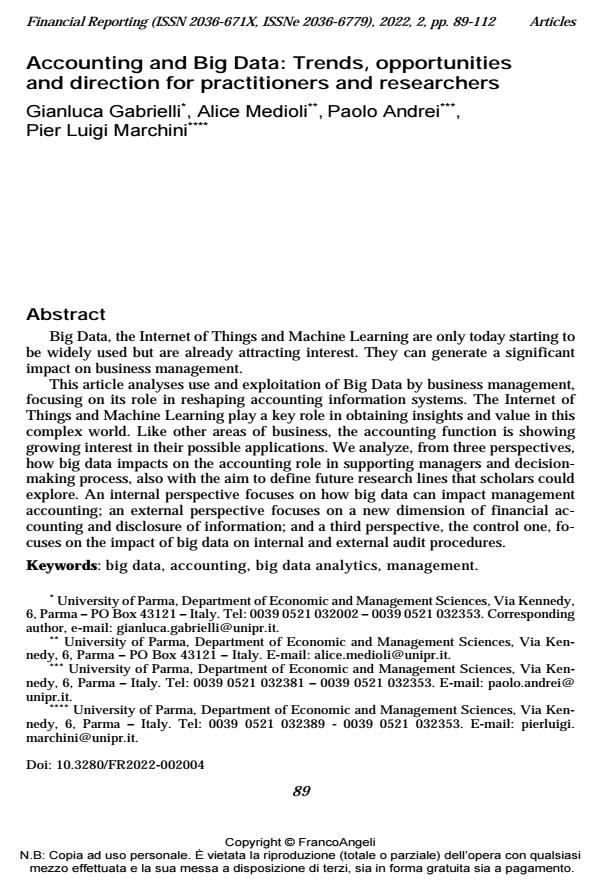Accounting and Big Data: Trends, opportunities and direction for practitioners and researchers
Journal title FINANCIAL REPORTING
Author/s Gianluca Gabrielli, Alice Medioli, Paolo Andrei
Publishing Year 2022 Issue 2022/2
Language English Pages 24 P. 89-112 File size 104 KB
DOI 10.3280/FR2022-002004
DOI is like a bar code for intellectual property: to have more infomation
click here
Below, you can see the article first page
If you want to buy this article in PDF format, you can do it, following the instructions to buy download credits

FrancoAngeli is member of Publishers International Linking Association, Inc (PILA), a not-for-profit association which run the CrossRef service enabling links to and from online scholarly content.
Big Data, the Internet of Things and Machine Learning are only today starting to be widely used but are already attracting interest. They can generate a significant impact on business management. This article analyses use and exploitation of Big Data by business management, focusing on its role in reshaping accounting information systems. The Internet of Things and Machine Learning play a key role in obtaining insights and value in this complex world. Like other areas of business, the accounting function is showing growing interest in their possible applications. We analyze, from three perspectives, how big data impacts on the accounting role in supporting managers and decision-making process, also with the aim to define future research lines that scholars could explore. An internal perspective focuses on how big data can impact management accounting; an external perspective focuses on a new dimension of financial accounting and disclosure of information; and a third perspective, the control one, fo- cuses on the impact of big data on internal and external audit procedures.
Keywords: big data, accounting, big data analytics, management.
- The digital (r)evolution in internal audits: are we there yet? Some insights from Italy Federico Bertacchini, Gianluca Gabrielli, Ennio Lugli, Pier Luigi Marchini, in Managerial Auditing Journal /2025 pp.129
DOI: 10.1108/MAJ-06-2023-3952 - The power of big data affordances to reshape anti-fraud strategies Gianluca Gabrielli, Carlotta Magri, Alice Medioli, Pier Luigi Marchini, in Technological Forecasting and Social Change 123507/2024 pp.123507
DOI: 10.1016/j.techfore.2024.123507 - Elections and earnings management: Further evidence from Benford's law Francesco Capalbo, Luca Galati, in FINANCIAL REPORTING 2/2024 pp.105
DOI: 10.3280/FR2024-002005 - INTERNATIONAL CONFERENCE ON MODELLING STRATEGIES IN MATHEMATICS: ICMSM 2024 R. Jayashree, S. Jayakani, pp.030028 (DOI:10.1063/5.0276496)
Gianluca Gabrielli, Alice Medioli, Paolo Andrei, Accounting and Big Data: Trends, opportunities and direction for practitioners and researchers in "FINANCIAL REPORTING" 2/2022, pp 89-112, DOI: 10.3280/FR2022-002004